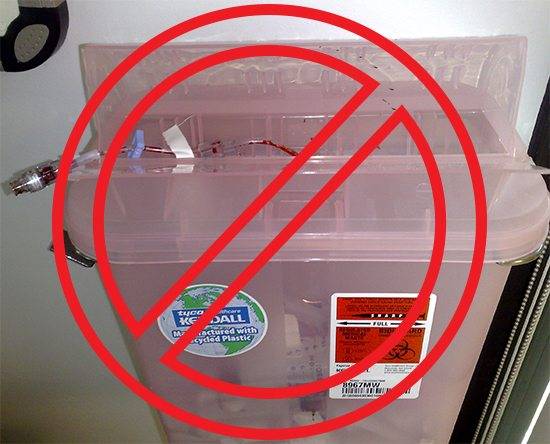The Many Types of Waste
There are many details to keep track of in any busy doctor’s office. So it can be difficult to sort out your practice’s medical waste properly while handling all of the other activities that occur on a daily basis. That’s why we want to provide you with a helpful reference you can use without taking time away from your patients’ needs.
Consider this blog as a guide to assist you when you’re ready to categorize the waste your office generates each day.
Find Out How Much You Can Save Instantly.
Try our on-line savings calculator.
Solid Waste
Regular solid waste (non-contaminated) can include:
- Non-confidential paper
- Plastic
- Unbroken glass products
- Empty IV bags
It’s important to note that liquids classified as non-hazardous can be poured down the drain. You shouldn’t include non-hazardous liquids in regular solid waste trash. Also, labels, paperwork or anything that has patient identifying information must be made unreadable before being discarded.
Sharps Waste
Sharps waste can include:
- Any item that can pierce or puncture skin
- Needles/syringes with or without attached needle
- Broken glass
- Glass slides
- Disposable sharp instruments or tools
- Razor/scalpel blades
Keep in mind that uncontaminated syringes (without needles) can be placed in with regular garbage or sharps containers.
However, all sharps waste must be put in special sharps containers. In addition, you have to make sure these containers are labeled: “Sharps Waste” or include the biohazard symbol. Don’t forget to put your facility’s name, address and telephone number or electronic tracking system information.
Also, there’s often confusion about whether or not chemotherapy-contaminated items or syringes with needles containing drugs belong with sharps waste. But the fact is that chemotherapy waste is in a different classification. So it should not be mixed with sharps.
Biohazardous Waste
Waste is biohazardous when it’s contaminated with liquid or saturated blood and/or infectious body fluids. These types of waste include:
- Blood in tubing or syringes without needles
- Containers of blood or body fluids
- Saturated or caked with blood or body fluids dressings and pads
- Biohazardous bags
Once you’re ready to dispose of biohazardous waste, it’s essential that you use red bags that are labeled: “Biohazardous Waste” or include the biohazard symbol. The bags must also include your office’s name, address and phone number or electronic tracking system information.
After following these steps, the biohazardous waste can then be placed in a biohazardous waste container that’s lined with a red plastic bag and covered with a lid.
It’s important to remember that tissue specimens and pharmaceutical items should not be mixed in with biohazardous waste.
Trace Chemotherapy Waste
Trace chemotherapy waste is classified as materials that are used to prepare and administer chemotherapy drugs. Furthermore, they do not have any liquid or powder that can be scraped or poured.
This waste includes:
- Gloves
- Gowns
- IV bags
- Pads
- Syringes
- Tubing
- Empty chemotherapy vials
To dispose of trace chemotherapy waste, you must place items in a yellow leak-proof and puncture-resistant container that has a tight-fitting lid. Each container needs to specify your office’s name, address and phone number. The words: “Chemotherapy Waste” and “Chemo” need to be on the label as well.
Pharmaceutical Waste
Pharmaceutical waste includes a wide range of partial, damaged, contaminated items or unwanted medications such as:
- Antibiotics
- Eye drops
- Over-the-counter medications
- Partial tubes of ointments
- Half or dropped tablets
If you have unused or unspiked IVs, they can be returned to the pharmacy for credit.
In terms of disposing pharmaceutical waste, be sure to place items in a leak-proof, puncture-resistant white container with a blue/purple lid. The information on this container should have your facility’s name, address and phone number. Also, remember to write: “Incinerate Only” on the lid and all sides of the container.
Hazardous Pharmaceutical Waste
Some examples of hazardous pharmaceutical waste include:
- Pourable flammables (rubbing alcohol, tinctures etc.)
- Partially used metered dose inhalers
- Partial tubes of nitroglycerin ointment
Certain items are not considered hazardous pharmaceutical waste. The include:
- Bulk chemotherapy
- Sharps
- Nitroglycerin drips
- Epi-cal drips
- Alcoholic liquids with less than 24 percent alcohol
Please note: hazardous pharmaceutical waste should be returned to the pharmacy.
One Final Note
It can be confusing to know how to classify each item of waste from your medical office. Hopefully, though, this list will give you a better idea about where to place medical waste materials so that they are disposed of properly at all times.




